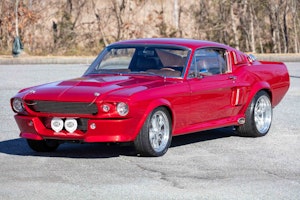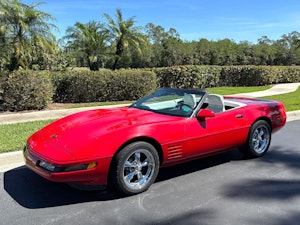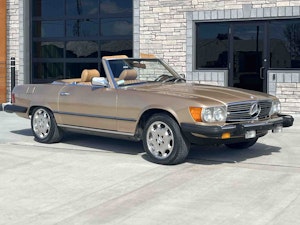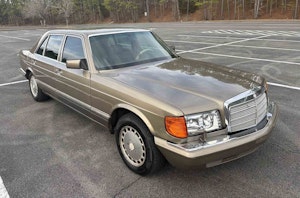Media | Articles
The Prize Becomes an Albatross
Last week, I was over the moon about finally using the Armada to tow home a well-priced rust-free running BMW E30 3 Series—specifically, a 1988 325is five-speed with the sport package. When I learned that I bought it ten years to the day after buying my last E30 sport-package 325is, and that the two cars appeared to be dopplegangers—both big-bumpered and Zinnoberrot red—I felt that the purchase was cosmic and thanked The Automotive Powers That Be, as I do when thanks (or prayers) to these greater entities are appropriate. The car had a rebuilt salvage title, but as I said with a certain degree of bravado, I didn’t care, because I’m experienced enough to know that a salvage event 32 years ago isn’t nearly as important as the combination of price and the condition the car is in now.
And then The Automotive Powers That Be smote me for my hubris. The purchase was an astonishingly poor decision that could’ve been easily avoided, and will forever serve as a cautionary tale in what can go wrong buying a car, particularly one with a salvage title, even if it’s well-priced and rust-free.
Since the E30 3 Series uses the M20 motor—the only engine BMW built with a timing belt—and since the seller said the belt was last replaced when he bought the car in 2001, the car made one quick stop in my driveway so I could Gunk the engine and hose off at least the first layer of decades of grime, and then went straight into the back corner of the garage where I began tearing it apart to replace the belt before it snapped and caused the pistons to crash into the valves.
As I began working on the car, the image of me being in any way lucky rapidly unraveled. It began with a literal trickle. There was a rivulet of oil running across the bottom of the oil pan. I didn’t think anything of it at first, as the lower engine and steering rack were coated with the grime present on any unmaintained car. I assumed it was the front main seal leaking, with the trail running rearward because I had the nose of the car on jack stands. But when I wiped the rivulet off, I could see that it actually originated in a small divot near the front of the pan. So I’m the proud owner of an E30 with a cracked oil pan. I sighed and made a mental note to try stanching the leak with J-B Weld before considering more invasive and permanent solutions.

The next bump in the road occurred when I pulled out the radiator. The circular pattern of flattened cooling fins is clear indication that the water-pump-mounted fan has been hitting it for quite some time. This is often due to worn-out engine mounts causing the engine to tip forward on braking, but can also be due to accident damage causing the radiator to simply be too close.
Marketplace
Buy and sell classics with confidence

I posted the radiator photo to my Facebook page, and folks who know more about E30s than me (a phrase that would soon come to haunt me) commented that this is a “pre-facelift” radiator that’s no longer available, and wondered why it was in my 1988 car. That led me down the unexpected rabbit hole of what the distinctions are between early and late E30s and where my car falls on that line.
I knew enough about E30s to be aware that the first was the 318i with big chrome “diving board” bumpers and the four-cylinder engine, followed by the 325e with the low-revving 6-cylinder 128 hp “eta” or “e” engine. The 325e was supplanted in 1987 by the 325i with the high-revving 168-hp “i” engine. The facelift came in 1989 when the big bumpers gave way to small ones that are color-keyed to the body.
However, that last part turns out to be incorrect. The facelift and its myriad of changes came in 1988 and is most easily distinguished by the larger rear taillights whose reverse indicators changed from vertical to horizontal. 1988 turns out to be unique in that it has the facelifted body but retains the bigger chrome bumpers. As part of the facelift, the cooling system was updated. The expansion tank was moved from the passenger-side inner fender to the driver’s side, the extra port on the neck of the water pump from the expansion tank was deleted, and a redesigned radiator, a metal crossover pipe, and a 3-way hose were employed to make it all work. Eagle-eyed E30 friends noted that, in a photo I’d posted of my engine compartment, the expansion tank was on the right. That, combined with the old-style radiator, pointed to my car as being pre-facelift.

And yet, the presence of the larger taillights with the horizontal reverse lights (and the 3rd brake light) clearly denoted a post-facelift car.

Hmmmn.
I rechecked the CarFax as well as ran the VIN through a BMW VIN decoder, both of which I’d procured before driving out to look at the car. The latter indicated that the build date was 7-29-1987, which is rounded off to 08-1987 on the sticker of the car’s door jamb. There are numerous sources that state that BMW closes down its German plants in August for worker vacation, and that the changeover to the new model year occurs when workers return. In addition, numerous parts websites use 9/87 as the pre-and-post-facelift demarcation. The website realoem.com, which is basically a portal into BMW’s online parts database, agrees with my door jamb sticker that the VIN maps to 08/1987. It doesn’t tag parts as pre- or post-facelift, but it lists the radiator and water pump for my VIN with part numbers that map to pre-facelift parts. However, it lists the new-style driver’s-side expansion tank as being correct for my car, which doesn’t jibe. And I noticed that there’s a plugged-up three-way hose, indicating that the plumbing for the cooling system is post-facelift. So I’m unsure what it originally was.

A lawyer-and-E30-expert friend who applies his Perry Mason-like approach to these sort of problems (“Isn’t it all true, Mr. Siegel?”) gave me his blunt opinion: The question of where the expansion tank is mounted isn’t a trivial one because on early cars it mounts on brackets, whereas on facelifted ones it’s attached to a post. Both of these mounting schemes are part of the inner fenders. And my car’s nose appeared to be pre-facelift as well. The facelifted rear but non-facelifted front wasn’t the kind of thing that would occur during a transition period on the assembly line; it would be all one or all the other. Plus, there was no denying that I bought an E30 with a rebuilt salvage title from an accident in 1992. This wasn’t the kind of situation where, when a car is at the bottom of the depreciation curve, it can be totaled by a bumper tap. A 1988 BMW 325is had a lot of value in 1992. For the insurance company to total it, it likely had a major accident. In his opinion, it all added up to the likelihood that this was a Franken-car, with possibly that the front of one car was grafted to the cowl-on-back of another.
My reaction, of course, was denial. I looked at the VINs. The stamped-in VIN on the cowl matched the VIN on the title as well as the VIN decals on the trunk lid and doors. But when I continued forward, I saw that the VIN decals on the front fenders and hood were from a different car. I ran the decoder on it, and it was a 325e with a build date of pre-facelift 02/1987. Its CarFax didn’t show an accident, but instead showed nothing after 05/1991.
Oh dear.
While I don’t see any big ugly welds under the car clearly indicating where two different E30s were spliced together, I have to admit that the bulk of the evidence shows that, in rebuilding the car from the event that totaled it and gave it a rebuilt salvage title, a donor vehicle was used from which the hood and fenders came. There’s no VIN tag on the nose because it’s an integral part of the body instead of a bolt-on panel, but I can’t imagine that a total that took out the hood and fenders didn’t also take out the nose. This is likely why the nose is also from a pre-facelift car. The inner fenders are still a mystery. I’m not a bodyman; I can’t tell whether or not they’ve been replaced. The cooling system I think is likely an early one grafted into a facelifted car.
Obviously I was less than thrilled about any of this. It’s one thing to knowingly purchase a salvage car with some event in its distant past that totaled it and where body panels were replaced. It’s another thing to buy something that’s been stitched together in a way that will make other enthusiasts point and howl like Donald Sutherland at the end of Invasion of The Body Snatchers at the pre-facelift nose on the post-facelift body and thus immediately and dramatically cap the value of the car.
But after living with this knowledge for a day, I let it mostly wash off. The car still was what I drove out to upstate NY to buy—an essentially rust-free running 325is for a good price. I mean it’s not like it has the low-revving “eta” engine in it.
It does have the correct high-revving “i” engine, right?
RIGHT?
Oh crap.
Unlike the engines 1970s-era BMWs, engines in E30s aren’t stamped with the VIN, so there’s no at-a-glance way to see if you have the original engine. The “e” and “i” engines used the same block but different reciprocating internals, different heads, and different manifolds and electronics. The spacing of the intake tubes and the absence of a cold start injector clearly show that this engine has an “i” intake manifold, but pulling off the valve cover revealed two crucial hallmarks of the “e” head—single instead of double valve springs, and the cam only being machined with four bearing surfaces instead of the full seven available in the head. The nail in the coffin was seeing that the tachometer has a 5,000-rpm redline instead of the 6,250-rpm one that the 325is is supposed to have.
So it seems nearly certain that the “e” engine, along with the body panels, came over from the 02/87 donor car.
Damn it!
I’ve owned over 40 BMW 2002s. I know them well enough to tell a Franken-car at a glance. The most common discrepancy is the nose from a later car with black plastic grilles attached to an early body with round taillights and small bumpers (for a while, only the later nose was available). Smaller issues include seeing the later one-piece dash and faux wood-grained instrument cluster in an earlier car. Whether any of these are abominations against man and God is up to you. I tell people that if the car fits their budget and a “correct” one doesn’t, and they like it and are buying it to enjoy and not to invest in, don’t worry about it. But this is so totally not what I signed up for.
Oh, and if that’s not enough, there’s the mice. I did get a snoot full of rodent urine when I opened up the trunk, but in my 30-second test drive around the parking lot, my mouse-dar wasn’t set off. Had I moved the sliders to open the cabin air vents or turned on the blower fan, I would’ve been deluged with it, because the mouse infestation is serious—the entire cowl was packed end-to-end with a mouse nest, and from there they got past the blower fan and into the heater box.

So. I screwed up big time. It happened because a) I don’t know E30s nearly as well as 2002s, b) I was in a rush because it was raining when I looked at the car, and c) my goal was only to verify that the car was as described, meaning essentially rust-free and running. Even though I wanted a knock-around E30, I don’t buy cars for investment, and I don’t do the “underwater” calculation of “I could buy it for X but it needs Y so I should instead pay 2X for a much nicer one,” this was a big mistake. What particularly galls me is that I make a big deal out of saying that I don’t buy cars sight-unseen because I don’t trust anyone and need to see things with my own eyes. The whole reason I bought the Armada was to enable me to do exactly this—pounce on cars that are within striking distance. I felt this was the right car on which to exercise that capability. And I was completely wrong. The presence of the low-rpm tachometer is a literal thumb in the eye. It was right in front of me during my short test drive.
The Franken-car status affects spending during the sort-out process in a challenging way. I ordered the timing belt and water pump even before I began pulling things apart because the belt hadn’t been replaced in 23 years, you can’t afford to be wrong about it, and you’d be an idiot not to replace the water pump at the same time. I ordered three new main cooling hoses, as they were old and they’re only ten bucks each. I also ordered a new intake boot as it was split in several places, and obviously new spark plugs and filters. But normally I’d replace that fin-flattened radiator (it’s NLA but aluminum ones are available) as well as the cooling fan and its clutch. Instead, I’m reusing parts unless they’re broken. To get around the badly dry-rotted tires, I’ll temporarily swap over a set of wheels off another car. I need to drive the car and see what it is and how it feels before I go all-in on a more serious sort-out effort.
For the de-mousing, pulling the climate control box out of the car is a fair amount of work, so I’m seeing if I can adequately clean it by sliding out the fan, heater core, and evaporator core and reaching in and cleaning all the hard plastic surfaces with the same enzyme-based cleaner I’ve used on other vehicles.
When I first saw the photo in the ad for the car that shown a worn bolster in the driver’s side sport seat, I began looking at seats, even wondering if I should continue out to Schenectady to buy a set from a fellow I’ve dealt with before. Now I look back wistfully at the short period when I thought that the worn seat (and then the cracked oil pan and radiator) were my biggest concerns.
Boy is this ever a cautionary tale. If you’re not familiar enough with a particular make and model to know its details, the car you’re considering buying could be absolutely anything. And it can happen to anyone. Even me. On a car I’ve owned several of. I do, however, take some solace in the way I regard risk. I’ve long said that if I buy a $50,000 car and am half wrong about originality or provenance or rust, I’m out 25 grand, but if I’m half wrong about a $5,000 car like this, I’m out $2,500. And by the time the car is up and running, it may not be that bad. Hell, I may even like it.
But it still totally sucks.
***
Rob’s latest book, The Best Of The Hack Mechanic™: 35 years of hacks, kluges, and assorted automotive mayhem, is available on Amazon here. His other seven books are available here on Amazon, or you can order personally inscribed copies from Rob’s website, www.robsiegel.com.


















I guess you had a bad case of OPTIMISTIC BIAS with this one, 🙂
Seriously, anyone could have fallen for that. Specially under the circumstances (drizzle, mud, getOutOfHereItis, etc).
I would personally make it a clean, nice driver. With shiny red paint, you’ll soon have people on the street asking you whether you’d sell it.
Rob, the depths of your painful disappointment is acknowledged. I’m speculating you did not want or need yet another project car. Any of us likely have experienced buyer’s remorse, at least once, after enthusiastically-embracing another acquisition. Rats; hate when that happens.
Try to look at it this way: regardless of your previous 325is ownership, you STILL have a cool, ‘driver-quality’ 325 that you can be content will never, ever need to be restored to concours-perfection, or ever employ OCD caution every time you drive it (or ever experience regret for selling it).
As long as repairs were done adequately (tracks well, and nothing rattles, creaks or groans as you throw it into corners), and runs well, overall, you still have something you can thrash with impudence, and actually enjoy driving.
The key point is, and I’m sure everyone would agree, if anyone can make a silk purse from a sow’s ear, it’s you. Who knows; someday, the ‘correct’ engine may just drop into your lap (or maybe even a better one, since the opportunity to swap/upgrade is open),
Sometimes buyers remorse is better than thinking about the one that got away.
THAT is a very astute way of looking at it. Thanks.
Back in the 70s or 80s, my brother bought a BMW that had been wrecked badly enough to need the frame straightened. After that, he always claimed that BMW stands for “Bavarian Money Waster.”
I really don’t get all of The Hack Mechanic’s hand-wringing.
I guess I must not be an enthusiastic because I see no problem with a stitched-back-together shell if it is done well enough that the metal work isn’t obvious. Then again one of the reasons that I like VWs is the parts interchangeability allows one to put together option package combination packages that the factory never did.
In the early 90s I bought a used 1986 545i, 5 speed with 85k miles on it. Black and black. Beautiful car but would not stay out of the shop. A/C went out, then exhaust system, then shifter handle broke, then the ignition came out in my hand when I went to start it. Goodbye BMW. I sold the car and about one month after I sold it the guy that bought it called me and asked if I had ever had any problems with the driver’s seat. The answer was no. He told me he was accelerating getting on the interstate and the back of the driver’s seat totally broke off and fell in the back floor. Not close to your issues but that was my last BMW. Thanks for your story!
Three old phrases that all apply come to mind:
a. Just because you can, doesn’t mean you should.
B. Sleep with dogs, you get fleas.
C, I never made a mistake in my favor.
Many other highly skilled mechanics like you have made mistakes like this. I have too. I have purchased a number of cars and motorcycles that turned out to be far less than I had hoped. It happens to me every time I buy on the internet. It’s not the end of the world. Step back and take some time before you consider what to do with this car. It still might be worth putting some work into and could still turn out to be a fun car.
That sucks. Hopefully it will work out on the end. It’s not great start for sure.
My brother in law bought a Mercedes 380SL for 3k. from a small lot. It was a nice clean, rust free Calif car. We knew this model had timing chain issues. This car had that issue fixed and ran and drove well. After around 2k mi the subframe broke totaling the car. I heard of this weakness to late. Do complete research on any car for design faults.
I am old, have had many cars over the years, and have mistakenly bought a few cars like this.I am going to swim against the current of the above posts and say get rid of it now. Take the hit. Don’t throw good money after bad. Just because you have the skills to fix it doesn’t mean you should. There are better cars to use as a canvas out there than this one. Don’t even hesitate. List it today. Or donate it to your favorite charity.
A friend once brought me a boxful of BMW 6 parts. Interesting story- he was driving ‘vigorously’ and the harmonic balancer separated. The balancer hit and cracked the radiator on the way to the ground, bounced, hit and cracked the cast aluminum oil pan AND the cast mag oil pump pickup inside, bounced a third time and cracked the tranny right where the case and tailshaft housing meet. I have a TIG & mill, and saved the owner many hundreds of dollars in OEM parts. The next year, the cylinder head arrived with a dropped seat….
Some people should just never be paired with some cars! No, the owner was not Rob Siegal. FWIW, there exists a simple radiator fin-comb tool for straightening bent-over rad fins at home.
That’s “door jamb”.
Whoops!
Rob way back in the day, a friend had a genuine Spridget…the front half was an Austin Healey Sprite, the rear half, MG Midget. The nose said Sprite, the deck lid, MG. It was well done and ran/handled fine.
I drove an 87 325e for 10 years. Got it cheap as a winter car and quickly discovered that eta engine was no slouch…more torque than an is engine and coupled with that 2.87 differential made well over 30 mpg on the highway. If you do the is head swap, remember the eta engine has a cast vs forged crank so be circumspect about revs…but once sorted, you’ll learn to like etas.
Good candidate for a track car?